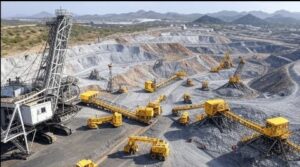Total Mineral Resource of:
25.9 million ounces of Silver contained in 9.6 million tonnes @ 84g/t Ag
including a High Grade Zone of:
15.3 million ounces Silver contained in 2.2 million tonnes @ 219g/t Ag
Azure Minerals Limited (ASX: AZS) (“Azure” or “the Company”) has delivered a key milestone in the advancement of the Mesa de Plata silver deposit in Mexico with the release of a near-surface, multi-million ounce JORC Mineral Resource, located in Sonora, Mexico, (see Figure 1)
Highlights
- Mesa de Plata is estimated to contain 25.9 million ounces of silver metal (refer to Table 1)
- 15.3 million ounces of this silver is within the near-surface High Grade Zone
- 100% of the resources are JORC Code reportable Indicated Mineral Resources
- Mineralisation, including the High Grade Zone, is open to the northwest and northeast
- Drill hole MDPD-014 (located 75m to the northeast and outside of the Mineral Resource) has intersected:
- 17.3m @ 45g/t Ag from surface; and a further
- 19.5m @ 68g/t Ag from 26.5m
- ?Potential high-grade extension at Mesa de Plata Norte will be drilled shortly
Table 1: Mesa de Plata JORC Code Indicated Mineral Resource
| Estimation Zone | Tonnes (millions) | Ag (g/t) | Ag Metal (million troy ounces) |
| High Grade | 2.17 | 219.3 | 15.3 |
| Mid-Grade | 7.42 | 44.3 | 10.6 |
| TOTAL | 9.59 | 83.9 | 25.9 |
| Notes: The toal Mineral Resource estimate is reported using a >20 g/t Ag Block cut-off grade based on capped grades estimates. Note the high grade part of the estimate is exclusive of the medium grade so the total resource is the sum of the two estimation domains. |
Azure’s Managing Director, Tony Rovira, commented: “I’m very pleased to present this first Mineral Resource for the Mesa de Plata silver deposit. In particular, the High Grade Zone presents an attractive near-term development option, and we’re currently investigating this possibility. Additionally, I’m very confident that our recent exploration successes at the nearby Loma Bonita prospect, which has both gold and silver mineralisation, will significantly enhance the overall project.”
The completion of this Mineral Resource paves the way for Azure to continue to rapidly progress the Mesa de Plata project by:
- Drilling to expand the known Mineral Resource:
- Immediately to the northeast of the deposit (potential already evident from MDPD-014);
- 300m to the north at Mesa de Plata Norte where high grade silver mineralisation is present in outcropping rocks similar to those that host the Mesa de Plata deposit;
- Infill drilling to upgrade the High Grade Zone confidence to the Measured Resource category;
- Large diameter core drilling to collect bulk samples for metallurgical test work; and
- Early-stage development work to fully assess the potential development options.
Additionally, exploration drilling will continue at the nearby Loma Bonita and Puerto del Oro goldsilver prospects (see Figure 2), and other areas where ongoing reconnaissance is identifying new targets.
MESA DE PLATA MINERAL RESOURCE ESTIMATE
The Mesa de Plata Mineral Resource estimate has been prepared in accordance with the requirements and guidelines of the JORC Code (2012), and is detailed in the JORC Code summary tables appended to this release.
Mr Mark P. Murphy, Technical Director of Mining and Geology of Amec Foster Wheeler of Perth Western Australia, has prepared the Mineral Resource Estimate. Mr Murphy qualifies as a Competent Person, as defined under the JORC Code.
Geological Setting
Silver mineralisation at Mesa de Plata is hosted in a unit of sub-horizontal to gently northeast dipping volcanic strata. The mineralised host rock crops out extensively along a 1,000m long by up to 300m wide ridge.
The deposit was formed through high-sulphidation epithermal processes which preferentially altered and mineralised a favourable horizon, resulting in the mineralisation being hosted in a unit of silicified volcanic rocks and residual quartz (vuggy silica). The contact zone between the mineralised siliceous zone and the underlying footwall andesite, which can be up to 5m wide, comprises weakly mineralised andesite which gradationally changes to a barren andesite.
Potential Extensions
Drilling completed after the Mineral Resource estimation process (holes MDPD-013 & 014) has identified significant silver mineralisation to the northeast of the resource limits (refer to Table 2 & Figure 2). Significantly, diamond drill hole MDPD-014 has intersected two thick zones of silver mineralisation of 17.3m grading 45g/t Ag and 19.5m grading 68g/t Ag, both being approximate true thicknesses. Azure considers that these results indicate that there is potential for extending the Mesa de Plata resource to the northeast.
Table 2: Significant silver intercepts from MDPD-013 & 014.
| HOLE No. | FROM (m) | TO (m) | WIDTH (m) | GRADE Ag (g/t) | EAST (mE) | NORTH (mN) | ELEVATION (mASL) | AZIMUTH | DIP |
| MDPD-013 | 0.0 | 3.0 | 3.0 | 32 | 571925 | 3415572 | 1,505 | 000 | -90 |
| MDPD-01 | 0.0 | 17.3 | 17.3 | 45 | 572014 | 3415446 | 1,526 | 000 | -90 |
| and | 26.5 | 46.0 | 19.5 | 68 | |||||
| which includes | 31.7 | 35.4 | 3.7 | 168 |
Dimensions and Geometry
Mineral Resource definition drilling has confirmed that silver mineralisation within the Mesa de Plata deposit starts from surface and that the overall mineralised zone has a true vertical thickness of up to 70m (see Figure 5). The mineralisation extends throughout Mesa de Plata with good internal continuity of silver grades.
The High Grade Zone of silver mineralisation commences at or very close to surface, and extends over a surface area of approximately 400m x 150m, with a true vertical thickness ranging from 20m to 50m. The High Grade zone is encapsulated within the larger Mid-Grade Zone of silver mineralisation which extends along the full length and width of the Mesa de Plata ridge, which in places is 300m wide and has a strike length of over 1km (refer to Figure 4).
Sampling Details
The Mineral Resource definition drilling involved two Reverse Circulation (RC) programs and one diamond core drill program, totalling 61 RC holes (for 5,504.7m of sampling) and seven diamond holes (for 852.2m of sampling – see Figure 3 for the drill hole collar locations). Only one diamond hole has been used for the Mineral Resource estimate to avoid clustering issues in the estimation process, but core measurements from the other diamond holes have been used to estimate the rock density. There are 3,746 assayed samples in the Mineral Resource database.
The Mineral Resource definition RC drill hole spacing is on a 50m x 50m pattern covering a northwest-southeast extent of 1,000m and a width of up to 300m. All RC holes were drilled vertically to depths of up to 90m. Samples of RC cuttings were collected over 1.5m intervals and passed through a Jones riffle splitter to produce a 1/4 split sub samples with an average mass of 6kg. All samples were collected in dry ground conditions.
Three of the diamond holes (MDPD-001, 002 and 004b) twinned RC holes and two (MDPD-003 and 005) were inserted into the 50m x 50m pattern. A further two diamond holes (MDPD-002a and 004) were terminated early due to difficult drilling conditions. All diamond holes were drilled vertically to depths of between 75m and 203m, and all holes were surveyed for down-hole deviation with surveys taken at 30m intervals and at bottom of hole. Drill core was saw-cut longitudinally and quarter core samples were collected for assay. Sample lengths for assay purposes were guided by changes in geology and varied from 0.15m to 1.5m.
Sample Preparation and Assaying
Sample preparation was undertaken by Acme Laboratories (a Bureau Veritas Group company) in Hermosillo, Sonora, Mexico. Samples were weighed, assigned a unique bar code and logged into the Acme tracking system. Samples were then dried and each sample was crushed to sub 2mm before a 250g sub sample was collected for pulverising to sub 75 microns. The 250g sample pulps were then dispatched via courier to Acme Laboratory in Vancouver, Canada for silver analysis.
The analytical technique for silver comprised four-acid digest followed by multi-element ICP-MS analysis. This technique is considered a total digest for silver. Following the four-acid digest, the analytical method used was MA300 which is an ICP-MS method with a maximum detection limit for silver of 200 g/t. ICP-MS over-limit results (> 200 g/t Ag) were re-analysed by assay method FA530, which is a 30g charge fire assay with gravimetric finish.
Metallurgical Test Results
A composite metallurgical sample was prepared from the RC drilling cuttings, and shipped to Xstrata Process Support for preliminary mineralogical evaluation using QEMSCAN and EPMA techniques. The sample was found to be predominantly quartz (80% by mass), with alunite and various iron oxides making up a further 14% of the sample mass. Two silver-bearing species were identified, namely:
- Bromian Chloroargyrite – (BrCl)Ag – containing up to 70% of the silver metal; and
- Sb-Pb-Fe oxides, contain up to 30% of the silver.
Preliminary test results indicate for a CIL-flotation process approach, 62% to 76% silver recoveries (ASX: 17 December 2015). Heap leach processing, albeit with lower and as yet undetermined recovery, is an option that is under investigation.
Density
A total of 153 density measurements were collected by Azure personnel from drill core selected from seven diamond holes. The volume of each core piece was measured using a 3D scanner typically used in industry to reverse engineer parts intended for 3D printing. The scans are extremely accurate and provide an accurate volume for the scanned material. Azure calculated density for these core samples by dividing the dry weight of the sample by the scanned volume.
Geological Estimation Domains
For the Mineral Resource estimation control, four estimation domains were identified, based upon silver grade thresholds. The volumes of the domains were modelled using conventional digital wireframing methods and the wireframe models were used to code a digital block model as follows:
- High Grade Zone – defined using a nominal >90g/t Ag grade cut-off and identified by an abrupt spike in silver grades. This is a distinct zone of very high grade silver in the center and upper part of the deposit in some areas, and presents as a narrow flat lying sheet in other areas.
- Mid-Grade Zone – defined as being between a lower grade cut-off of 20g/t Ag and an upper grade cut-off of 90g/t Ag. This zone forms a halo surrounding, below and occasionally above the High Grade Zone.
- Low Grade Zone – defined as being between a lower grade cut-off of 5g/t Ag and a medium grade cut-off of 20g/t Ag. This zone forms a narrow transition zone between the Mid-Grade Zone and the Waste Zone at depth, and also in the overburden on the northern and western flanks of the mesa.
- Waste Zone – comprised of andesite, this zone underlies the entire deposit and forms a barren footwall to the Mesa de Plata deposit. There is also barren overburden in some areas.
Sub blocks were included in the block model to closely honour the estimation domain boundaries and the topographic surface.
Reporting Cut-off Grade
The 20g/t Ag Mineral Resource reporting cut-off was selected based upon order of magnitude cost estimates from current silver mining and heap leach processing operations in northern Mexico, heap leach recovery inferred from current metallurgical tests, and assumed mining and metal pricing parameters. More details are given in the JORC Table 1 Section 3 appended to this ASX release.
Grade Caps
To reduce the spatial influence of extreme sample grades (some of which exceed 1,000s of g/t Ag), and based on decile analysis and probability plots, 1.5 m long estimation composite grades were capped to the following maximum values prior to block grade estimation:
- High Grade Zone – 1,450 g/t Ag (5 out of 275 composites capped)
- Mid-Grade Zone – 100 g/t Ag (18 out of 981 composites capped)
The caps selected that were applied to the estimation-sample composites are typically between the 98th and 99th percentile of the respective domain composite populations.
Criteria used for classification
The criteria used for JORC Code classification included, data quality, geological understanding, data spacing, estimation methodology and validation, with data spacing being the primary consideration give the data quality is good and geological understanding is robust. Only mineralisation within the High and Mid-Grade domains was considered reasonable to include in the JORC Code reportable Mineral Resource.
Refer to the Table 1 summaries in the appendix for full details.
Estimation and Validation Methodology
Using the estimation-domain coded block model, the capped silver grades were estimated from the capped composites using ordinary block kriging into a parent block sizes of 12.5mE by 12.5mN and 5m in elevation, with sub block grades estimated using parent block assumptions. The composite search routine for each block estimate was set to search horizontally and find three composites from the four nearest drill holes, so that the block reflected the kriging weighted average of 12 capped composites. A multi-pass search strategy with expanding search after each pass was used ensure estimates were made for all blocks.
The model was validated by on-screen visual inspection and statistical comparisons of (composite) input and (block estimate) output mean grades on a global and local basis. The block model grade validation results were deemed to be acceptable by the Competent Person.
Modifying Factor Assumptions
In terms of key modifying factors, it has been assumed that the deposit could be exploited by conventional truck and shovel open pit mining with ore processed either by heap leach methods or by CIL-flotation processes, with the metallurgical recoveries indicated by preliminary metallurgical test results. Using these assumptions and reasonable public forecast ranges of future silver prices a block reporting cut-off grade of 20g/t Ag was selected as a reasonable optimistic basis for reporting the Mineral Resource. Azure has further assumed that given the long history of mining in the Sonora region of Mexico that there are reasonable expectations that a mine and process operation could be developed at Mesa de Plata should (or when) future studies result in the definition of an Ore Reserve.
-ENDS-
For further information:
Original Article with Figures: http://www.azureminerals.com.au/azs//assets/2016/05/160509-Mesa-de-Plata-Mineral-Resource.pdf

















